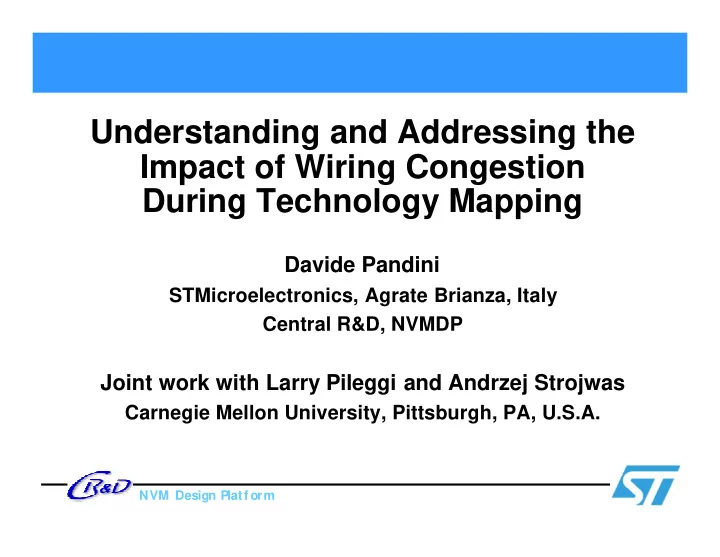

Understanding and Addressing the Impact of Wiring Congestion During Technology Mapping Davide Pandini STMicroelectronics, Agrate Brianza, Italy Central R&D, NVMDP Joint work with Larry Pileggi and Andrzej Strojwas Carnegie Mellon University, Pittsburgh, PA, U.S.A. NVM Design Platf orm
Motivation In DSM wirelength does not scale with feature size • � Cell area minimization no longer guarantees block/chip size minimization � The synthesized netlist may not be routable within the fixed floorplan constraints Congestion should be included in the synthesis • optimization objectives � In the traditional ASIC design flow no physical information is available before layout � Physical information can be effectively exploited during technology mapping The impact of any synthesis-level congestion • minimization approach can be evaluated only after detailed routing 2
Motivation Including congestion in the synthesis optimization • objectives yields sub-optimal cell area and/or delay � Trade-offs between congestion and cell area and/or delay minimization must be carefully considered Congestion-driven technology mapping can • effectively reduce congestion globally But localized congested regions may still persist • after detailed routing � Different layout areas may have very different routing demands � Both “global” and “local” nets along with the netlist structure and the routing resources impact on routability A single-pass congestion minimization approach is • not likely to work for all designs 3
Congestion-driven tech mapping Connectivity is captured after initial placement of the tech • independent netlist Placement coordinates are used during: • � DAG partitioning � Tree covering The congestion-driven tree covering cost function attempts to • place the fanin gates close to their fanouts = + ⋅ COST ( m , v ) AREA ( m , v ) K WIRE ( m , v ) The impact of wiring cost is controlled by the congestion • minimization factor K � By increasing K structurally routable netlists can be efficiently obtained � But a purely predictive congestion measure may yield a large cell area and an unroutable design 4
Proposed methodology Our congestion-aware tech mapping approach can • be easily integrated into the traditional ASIC design flow � By increasing the congestion minimization factor K structurally more routable netlists can be efficiently generated from the same tech independent netlist and its initial placement But a priori estimation of the optimal K value is • very difficult � The optimal K value is not constant across the chip layout image After routing localized congested areas can be • incrementally remapped instead of either relaxing the floorplan constraints or resynthesizing the whole circuit 5
Modified ASIC design flow Technology High Level High Level Tech. Indep. independent Description Description Optimization netlist Logic Synthesis Technology Initial Mapping placement NO Global placement Congestion OK? and cong. map Incremental remapping YES & placement Local rt. Place&Route Place&Route YES violations? Finished ASIC NO 6
Incremental remapping flow (I) Final global routing NO Local rt./cong. violations? YES Extract and decompose Finished ASIC congested subnetlist YES First iteration? NO YES NO Rt./cong. violations reduced? 7
Incremental remapping flow (II) YES NO Rt./cong. violations reduced? Incremental placement Minimum area remapping and remapping Insert back remapped subnetlist Incremental placement Rt./cong. violations? Routing update 8
Results The incremental flow has been implemented using • commercial tools, our congestion-driven tech mapper and various interface utility programs The cell library is the CORELIB8DHS TM 2.1, in • 0.18 µ m, by STMicroelectronics, Inc., and three metal layers have been used in all experiments Circuit PDC (IWLS93) • � 23K gates � Die size == 229786 µ m 2 Industrial circuit (courtesy of Central R&D, STM) • � 250K gates � Die size == 2131133 µ m 2 9
Results Circuit PDC – Congestion minimization Cell Area ( µ m 2 ) K Area Utilization % Rt. violations 0.0 128438 55.89 5447 0.00075 131477 57.22 3673 0.001 132514 57.67 0 0.0025 140161 61.0 28 0.005 147714 64.28 0 0.0075 151769 66.05 0 0.05 163103 70.98 158 0.5 178975 77.89 6270 1.0 180330 78.48 7770 Incremental remapping (28 initial violations) One iteration Cell Area ( µ m 2 ) K Area Utilization % Rt. violations 0.0 139727 60.81 0 0.01 139846 60.86 0 10
Results Industrial circuit – Congestion minimization Cell Area ( µ m 2 ) K Area Utilization % Rt. violations 0.0 1270309 59.61 22466 0.00075 1273250 59.75 29 0.001 1275687 59.86 44 Incremental remapping Cell Area ( µ m 2 ) Iteration Area Utilization % Rt. violations 1st 1273225 59.74 25 2nd 1272697 59.72 0 11
Results Tech mapping with K == 0.001 – 44 routing violations 12
Results Incremental flow – 1 st iteration -- 25 routing violations 13
Results Incremental flow – 2 nd iteration -- no routing violations 14
Conclusions We proposed a complete, efficient and robust • methodology for congestion minimization both at the synthesis and layout stage of the design flow Wiring congestion must be considered globally in • logic synthesis and locally in physical design � The impact of congestion minimization into the synthesis optimization objectives must be carefully evaluated � Different layout regions can have very different routing demands A single-pass approach for congestion • minimization is unlikely to work for all circuits and it will be successful only in a random, unpredictable way 15
Recommend
More recommend